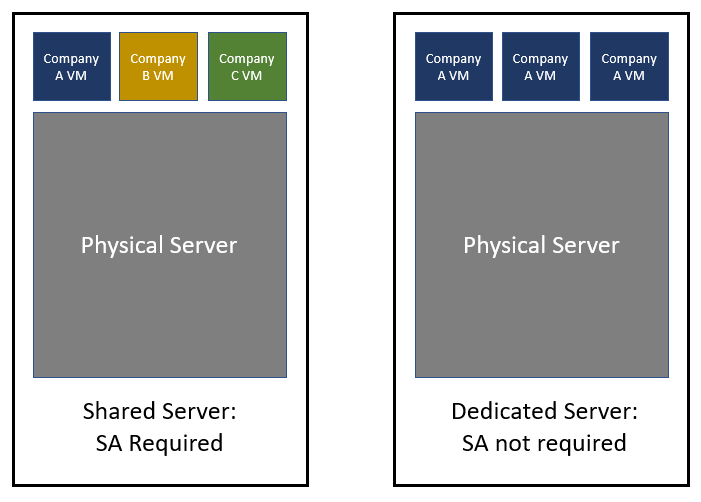This year’s biggest Microsoft licensing change (so far) – what you need to know.
Microsoft have made a new move in the Battle of the Clouds, with licensing changes that restrict competing clouds – whilst simultaneously making things more attractive when run inside Azure.

What’s the current situation?
When it comes to putting Microsoft application licenses into the cloud, there have long been 2 options:
- Purchase the license with Software Assurance (SA) to get License Mobility rights
- Put the license on a server dedicated to your use
Microsoft’s rules kick in when software is installed on “shared servers” – that’s where your instance is simply one of many virtual machines running on that physical server. That scenario is where SA is required, giving the additional rights required to run you on-premises licenses in that cloud environment.
The other option is to put your software on a dedicated server – so still hosted in the 3rd party datacentre but used only by you. No other organisation’s instances are run on that physical hardware, it’s just for your organisation. In this case, because the server isn’t shared, SA isn’t needed for the licenses to be used in this scenario.

Current situation prior to October 1, 2019
What’s changing?
Microsoft have announced that, from October 1, 2019, License Mobility rights – typically granted & acquired by purchasing SA – will be required even on dedicated hosts from specific public cloud providers – and they are:
- Microsoft
- Alibaba
- Amazon (including VMware Cloud* on AWS)
Henceforth knows as “Listed Providers”.
These cloud licensing changes will apply to licenses purchased from October 1, 2019 – while any licenses purchased before that date will retain the rights to be used on dedicated hosts with the Listed Providers. For Software Assurance customers, upgrading to a new version released post-October 1, 2019 will require you to comply with the new licensing rules.
*It’s interesting that they call this out but not the corresponding offerings on Azure and Google Cloud Platform. I assume that is an oversight rather than anything else.
So yes, SAM managers – that means you should start tracking the purchase dates of your Microsoft applications, as well as tracking which licenses are assigned to applicable 3rd party dedicated environments. You also need to be aware of upgrading existing Windows Server licenses, as that causes the new rules kick in. So if you already have Windows Server 2019 with SA in an Amazon Dedicated Environment, that’s fine…but if, when the time comes, you use your new version rights to upgrade that instance to Windows Server 2022 (or whatever the next release is called) – you can no longer run it in that dedicated environment.
Windows Server
The change requires licenses to have mobility rights to run on the dedicated hardware, and Windows Server does not include License Mobility rights – even with Software Assurance. This means that Windows Server cannot be used with the Listed Providers post-October 1, 2019 – even in a dedicated environment. It also means that Windows Server licenses have never been eligible to be moved into a shared server environment – the only option for using your on-premises Windows Server licenses in the public cloud is Microsoft’s Azure Hybrid Rights.
Once the change kicks in, you’ll need to acquire Windows Server licenses from the provider via SPLA…unless, that is, you’re using Microsoft’s new Azure Dedicated Host service – where Windows Server Azure Hybrid Rights can be used. See below for more information on this new offering.
Windows Desktops
If you have Windows desktops deployed on dedicated hardware with the Listed Providers – such as Amazon Workspaces – this rule changes affects you there too.
At your SA renewal, to continue running Windows Enterprise in this scenario will require Windows VDA E3/E5 per user licenses.
Of course, those licensed with Windows 10 E3/E5 or Microsoft 365 E3/E5/F1 can use Windows Virtual Desktop instead.
Why are they doing this?
Microsoft feel that:
“The emergence of dedicated hosted cloud services has blurred the line between traditional outsourcing and cloud services”
And that dedicated hosts, with the Listed Providers at least, offer many features that are similar to shared servers – including elasticity, on-demand provisioning, and a pay-as-you-go model.
What does it mean?
If you’re currently running Microsoft software on dedicated hardware with the Listed Providers, you don’t need to make any changes. However, if you plan to add additional licenses into those environments post October 1, 2019, you’ll have to have Software Assurance on those additional application licenses – and of course, make sure that the application in question supports License Mobility rights.
You will also be unable to deploy newly purchased Windows Server licenses into a dedicated environment, so you’ll need to look at costs for acquiring via SPLA with your Listed Provider. Alternatively, look at migrating your dedicated environment to Azure Dedicated Hosts and use Azure Hybrid Rights.
Azure Dedicated Hosts?
That’s right. Microsoft’s latest Azure release offers physical hosts dedicated to the use of a single organisation – which is exactly the type of environment at which these new licensing rules take aim. While Windows Server licenses purchased post October 1, 2019, even with SA, cannot be used in dedicated environments from Amazon, Alibaba, and Google – Microsoft have extended Hybrid Use Rights to work in their own environment. See more in my article here.
What about SPLA?
Microsoft are clear that this change doesn’t apply to providers other than those listed and that there will be no changes to the SPLA (Services Provider License Agreement) program.
Conclusion
This is quite a bold move by Microsoft, seemingly aimed at reducing the appeal of dedicated environments with Amazon, Alibaba, and Google – and, one assumes, hopefully causing people to migrate to Azure Dedicated Hosts and/or Azure public cloud services. Even if customers choose to stay with the other providers, it will reduce their reliance on “old school” on-premises licensing – which is one of Microsoft’s key goals – and see a (small?) uptick in SPLA revenue via the 3 competing providers.
Unsurprisingly, these cloud licensing changes haven’t gone down well with the affected cloud providers. Werner Vogels, CTO of Amazon, tweeted:
Yet another bait+switch by $MSFT, eliminating license benefits to force MS use. 1st, MS took away BYOL SQL Server on RDS, now no Windows upgrades w/BYOL on#AWS. Hard to trust a co. who raises prices, eliminates benefits, + restricts freedom of choice. https://t.co/h4RkFHzcjP
— Werner Vogels (@Werner) August 5, 2019
While Robert Enslin, President of Google Cloud sales, tweeted:
Shelf-ware. Complex pricing. And now vendor lock-in. Microsoft is taking its greatest hits from the '90s to the cloud. https://t.co/mtS2jmncsp
— Robert Enslin (@RobertEnslin) August 7, 2019
This change has certainly given ammunition to Microsoft’s competitors (such as this article from Sandy Carter, VP at AWS) about their tactics and, as Robert Enslin’s tweet shows, a chance to hark back to the “heyday” of frowned upon Microsoft tactics in the 1990s.
Anti-competitive
During the 1990s (and into the early 2000s), Microsoft faced several anti-trust investigations from both the US Government and the European Commission – focused around potential monopolies, anti-competitive practices, and licensing rules. Will the “Listed Providers” be thinking about something similar now?
I can only imagine these rule changes have been through quite a few people within the Redmond legal team and Microsoft must be confident that everything is above board, but it does seem these rules favour Microsoft over their competition.
Is it worth it?
Another question is whether this move will have a net positive outcome for Microsoft? Will organisations that have dedicated environments with Google, Amazon, and Alibaba simply swap over to Azure Dedicated Hosts? I don’t think so. I think such customers, and their providers, will use this as an opportunity to re-evaluate – “Why do we have these dedicated hosts? Can we re-architect and remove them?”; if they can, then it seems most likely they’ll stay with that provider. Azure Hybrid Rights are the big USP that Microsoft have over the other Listed Providers – the ability to use your on-premises Windows & SQL Server licenses (with SA) to reduce your cloud costs – how much of a draw will they ultimately be?
Forethought
These cloud licensing changes seem sudden, but I was thinking back to the launch of the Azure Hybrid Use Benefit (as it was then) and Microsoft were VERY keen to point out that this WASN’T the same as license mobility rights. Given the new distinction between license mobility and Azure Hybrid Rights, one must wonder if this has been on the cards for a couple of years.
Impact on ITAM
For ITAM, it adds an extra layer of complexity as the purchase date must now be tracked for software to ensure the correct outsourcing rules are applied. You need to identify all dedicated cloud environments you have with the Listed Providers and ensure the teams involved are aware of this rule change. You will also need a process to make sure, going forwards, only the correct licenses are used.
Finally, I can’t help but wonder what Oracle and IBM think about all this. The fact that they’re not considered enough of a threat to be included among the Listed Providers must surely smart a little?!
Further Reading
Microsoft Announcement – https://www.microsoft.com/en-us/licensing/news/updated-licensing-rights-for-dedicated-cloud
Microsoft FAQ – https://aka.ms/outsourcerights
Microsoft Corp. v Commission – https://en.wikipedia.org/wiki/Microsoft_Corp._v._Commission
United States v Microsoft Corp. – https://en.wikipedia.org/wiki/United_States_v._Microsoft_Corp
Windows Media Player Unbundling – https://arstechnica.com/uncategorized/2004/12/4480-2/
Azure Dedicated Hosts – https://itassetmanagement.net/2019/08/13/azure-dedicated-host-microsofts-new-cloud-offering/
Can’t find what you’re looking for?
More from ITAM News & Analysis
-
Software Vendor Insights: What do the numbers tell us about the opportunities for ITAM negotiations?
What software vendor insights can be gained from the latest financial results from Amazon, Google, Broadcom, Salesforce, IBM and SAP? An important part of ITAM is paying close attention to the health of the companies we ... -
Flexera is first SAM tool vendor verified for Oracle E-Business Suite applications
Flexera has announced that it has been verified as the first software asset management (SAM) tool vendor for Oracle E-Business Suite applications. Almost anyone with an Oracle estate will be familiar with the company’s License Management ... -
ITAMantics - March 2024
Welcome to the March 2024 edition of ITAMantics, where George, Rich and Ryan discuss the month’s ITAM news. Up for discussion this month are. Listen to the full ITAMantics podcast above or queue it up from ...